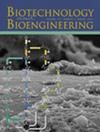A Genetic Algorithms-Based Neural Network Model to Monitor Gibberellic Acid GA3 Fermentation Process by Fusarium fujikuroi
IF 3.5
2区 生物学
Q2 BIOTECHNOLOGY & APPLIED MICROBIOLOGY
引用次数: 0
Abstract
A genetic algorithm-optimized neural network (ANN-GA) was developed for real-time monitoring of gibberellin (GA3) production during Fusarium fujikuroi fermentation. This model addresses the limitations of traditional off-line detection methods, such as contamination risks and delayed feedback, by integrating six critical inputs—initial glucose concentration, fermentation time, temperature, pH, dissolved oxygen, and rotational speed—to predict glucose consumption and GA3 synthesis with an accuracy of 99.41%. During the implementation phase, by dynamically controlling the temperature (28°C–32°C) and pH, the biomass accumulation rate increased by 84% within 48 h, while the GA3 accumulation rate improved by 66.7% compared to constant-temperature fermentation at 28°C. The ANN-GA framework enables dynamic adjustment of glucose supply based on real-time predictions, thereby optimizing carbon source utilization and enhancing process stability. This data-driven approach effectively overcomes the drawbacks of costly sensors and labor-intensive manual sampling, showcasing significant potential for industrial-scale fermentation optimization. With its high accuracy and adaptability, the model holds substantial application value in advancing intelligent biological process control for secondary metabolite production.基于遗传算法的神经网络模型监测赤霉病菌GA3发酵过程
建立了一种遗传算法优化的神经网络(ANN-GA),用于实时监测藤黑镰镰菌发酵过程中赤霉素(GA3)的产生。该模型解决了传统离线检测方法的局限性,如污染风险和延迟反馈,通过整合六个关键输入-初始葡萄糖浓度,发酵时间,温度,pH,溶解氧和转速-来预测葡萄糖消耗和GA3合成,准确率为99.41%。在实施阶段,通过动态控制温度(28°C - 32°C)和pH, 48 h内生物量积累率提高了84%,GA3积累率比28°C恒温发酵提高了66.7%。ANN-GA框架可以根据实时预测动态调整葡萄糖供应,从而优化碳源利用率,提高工艺稳定性。这种数据驱动的方法有效地克服了昂贵的传感器和劳动密集型人工采样的缺点,展示了工业规模发酵优化的巨大潜力。该模型具有较高的精度和适应性,在推进次生代谢物生产的智能生物过程控制方面具有重要的应用价值。
本文章由计算机程序翻译,如有差异,请以英文原文为准。
求助全文
约1分钟内获得全文
求助全文
来源期刊

Biotechnology and Bioengineering
工程技术-生物工程与应用微生物
CiteScore
7.90
自引率
5.30%
发文量
280
审稿时长
2.1 months
期刊介绍:
Biotechnology & Bioengineering publishes Perspectives, Articles, Reviews, Mini-Reviews, and Communications to the Editor that embrace all aspects of biotechnology. These include:
-Enzyme systems and their applications, including enzyme reactors, purification, and applied aspects of protein engineering
-Animal-cell biotechnology, including media development
-Applied aspects of cellular physiology, metabolism, and energetics
-Biocatalysis and applied enzymology, including enzyme reactors, protein engineering, and nanobiotechnology
-Biothermodynamics
-Biofuels, including biomass and renewable resource engineering
-Biomaterials, including delivery systems and materials for tissue engineering
-Bioprocess engineering, including kinetics and modeling of biological systems, transport phenomena in bioreactors, bioreactor design, monitoring, and control
-Biosensors and instrumentation
-Computational and systems biology, including bioinformatics and genomic/proteomic studies
-Environmental biotechnology, including biofilms, algal systems, and bioremediation
-Metabolic and cellular engineering
-Plant-cell biotechnology
-Spectroscopic and other analytical techniques for biotechnological applications
-Synthetic biology
-Tissue engineering, stem-cell bioengineering, regenerative medicine, gene therapy and delivery systems
The editors will consider papers for publication based on novelty, their immediate or future impact on biotechnological processes, and their contribution to the advancement of biochemical engineering science. Submission of papers dealing with routine aspects of bioprocessing, description of established equipment, and routine applications of established methodologies (e.g., control strategies, modeling, experimental methods) is discouraged. Theoretical papers will be judged based on the novelty of the approach and their potential impact, or on their novel capability to predict and elucidate experimental observations.
 求助内容:
求助内容: 应助结果提醒方式:
应助结果提醒方式:


